|
Please read response here from
people up-grading from standard PP caps to super-caps:
http://www.troelsgravesen.dk/Response-super-caps.htm
First of all this is not
an attempt to evaluate the sonic differences between super caps,
merely to find out what super caps are and why we pay an indecent
amount of money for them. I use the term "super-cap" for
caps costing in the range of 5-10 times the cost of a standard
polypropylene capacitor. We're used to paying in the range of 4-6 USD
for a 4.7 uF standard PP, where a similar super-cap is around 20-40
USD. Quite a difference.
Caps, like coils and resistors, are necessary evils in making our
speaker crossovers work in dividing the frequency band into the
sections meant for our drivers. Capacitors in series with our drivers
will prevent low frequences from reaching our drivers and form a
high-pass filter. Good coils and resistors can be made for very little
money, but capacitors are another story. Depending on materials used
and winding technique they will pass the signal with more or less
fidelity and the quest for better sound transmission really started
already in the Sixties and in the Seventies where we saw speaker
crossovers fitted with film capacitors, usually made from metallized
polyester in replacement of the common bi-polar electrolytic
capacitors. Metallised polyester was certainly not the final word in
this quest and metallised polypropylene became standard if we
wanted something better. Solen polypropylene soon became standard for
many speaker manufacturers launching high-end speakers.
Now, there are people who question the sonic value of super caps claim
them to be all hype and woodoo. To my experience the sonic benefits of
good caps can be heard from even modest equipment; the question is at
what time point we may start investing in good crossover components
compared to up-grading other parts of our system. Maybe money would be
better spent on a new phono cartridge or a better amplifier.
Identifying bottlenecks in out system is a never ending journey - and
part of our hobby.
I've had mails from people missing the "detail"
and - most surprisingly - "transparency" of e.g. Bennic caps once they
changed to super-caps. Bennic is to my experience at the bottom of the
quality ladder. To my thinking these people have gotten so
used to the sonic distortion of the Bennics, that this - to my ears -
harshness is perceived as detail and transparency. Whenever things get
darker from changing standard caps to super-caps, we're - to my
experience - on the right track. For the same values, uF, of the
capacitors, the frequency response will not change. The e.g.
treble level will be exactly the same as before, yet the hizz and
distortion poor caps add may be missed - and generally perceived as
detail and transparency. How our brain process the information from
our ears is an overlooked parametre - and one that cannot be
quantified. It's called taste and habit. Two very strong players.
In most marketing
material we will read that super caps are made from two
series-coupled, inter-wound capacitors, thus four times the normal
size of a capacitor of same value as two e.g. 10 uF in series will
measure only 5 uF. A standard cap looks like this (illustration from
Wikipedia):
http://en.wikipedia.org/wiki/Film_capacitor

To find out what we're
buying there's really no alternative to simply un-wind the caps and
see how they are made.
I've taken apart two well-known brands of super caps and this is what
I found:
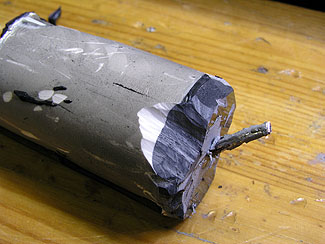
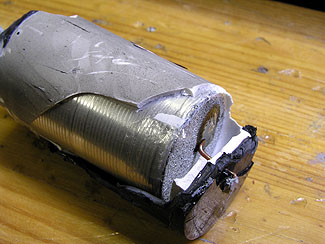
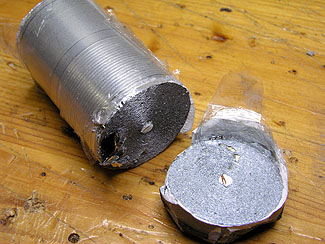
Un-winding a super cap takes time! Usually super caps are sealed in a
metal tube made from aluminum or brass, both non-magnetic materials.
Next we find various layers of extremely had ceramic-like material and
plastic fillings. I never thought plastic could be this hard.
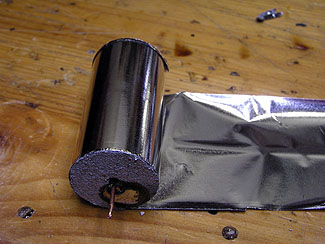
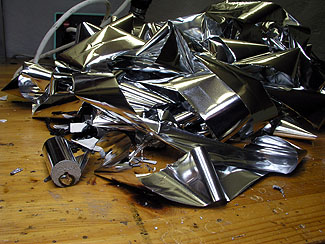
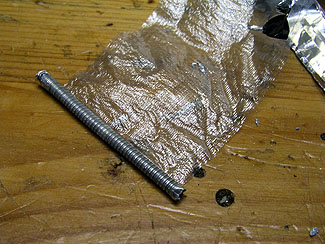
Maybe 30-50 meters of foil can be unwound from this 4.7 uF super cap! I
only made a rough estimate.

Please view image
above. This is where things become interesting as we at the end of the
foil can identify two foils, one foil consisting of a full width metallised
polypropylene with plastic foil edges, thus does not connect to anything. Laminated with this
foil is another foil having two lanes of metallised foil. What
we have is this:

As a matter of category,
super caps are "standard" high-voltage capacitors and well,
can be characterised as two series connected capacitors, in patent
terms "metalised film series section capacitors", and there
are quite a few patents in this field.
But there are more to
good caps than two-lane foils providing high voltage capability:
Quality of the foil, tightness with which it is wound and not least
the "wrapping", being molded into rigid materials and
finally sealed in tubes to prevent any vibration from distorting the
signal passing the capacitor. This is where things get tough. The
actual conducting foil
can be metalised polypropylene, usually aluminum, but also pure silver
or silver mixed with e.g. 1% gold. On top of this pure foil (no
plastic) can be
used with insulation made from oiled or waxed paper. The insulation
(yellow colour above = dielectric material) can also be teflon, which is particularly
troublesome in winding (soft and has holes. I've seen vintage Russian
teflon caps wound on two layers of teflon to overcome the problem of
holes in the foil as it is highly unlikely two holes would be at the
same spot).
And we shouldn't forget tin-foil. Tin has the advantage of
weight and by sheer weight reduce vibration. To my ears the most
cost-efficient caps for audio are tin-foil caps, but they rarely
deliver the ultimate resolution of super caps. Tin foil caps are
usually "standard" caps in terms of winding technique, but
are serious competitors to super caps, in particular as coupling caps
in amplifiers. I never tried tin-foil caps for speaker, but would like
to some
day. I guess
V-caps,
TFTF, are not double lane super caps, but made from tin-/alu-/copper-foil and Teflon, hence
the astronomical price tag, but I'm not sure and haven't taken one
apart.
Some super caps are also wound in a non-oxygen atmosphere, e.g. nitrogen. This prevents the extremely thin metallised foil from
being oxidised with possibly subsequent sonic degradation. Production
obviously becomes more expensive from these precautions, but whether
this really is an issue, we don't know. People come up with
a lot of stuff meant to make us believe their product is better than
others.
Latest
addition to the range of super-caps I've tested is the
Jantzen Audio
Alumen-Z, being a bit above double-lane super-caps, despite being a
single lane foil, rather than metallised polypropylene. They
provide the same resolution with a tad more neutral sound. The polypropylene foil separating the aluminium foil is very thin,
thus 100 volt max can be applied. This is by far good enough for
speaker crossovers. Reduced thickness of foil means less storage of
electrons = reduced memory = less smear of details. Whatever is going
on, these foil caps provide qualities on par with the double-lane caps
and the thing is that even double-lane caps can add a certain colouration to the sound - although miniscule.
Super-caps can sometimes
make music sound just a little bit better than life by adding a
certain sheen/glair/brightness/radiance to particularly high frequency
content. There may be psychoacoustics involved here leaving us to
believe one cap delivers more transparency than another. English is
not my native tongue and different words that may be used to describe
the issue, so take your pick. I wouldn't use the word lush.
Lush is more related to 2nd harmonic distortion to my thinking.
Currently I'm testing low-voltage copper foil capacitors (Jantzen
Audio Amber-Z) for
crossovers and these appear to even better the aluminium foil caps.
Not much, but a little. Major problem with copper foil caps is size
and not least costs. They cost a fortune.
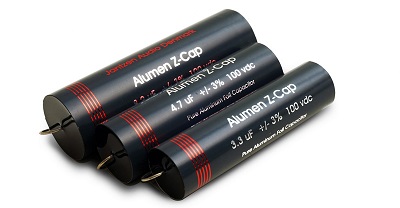
Single lane foil, high-res,
thin insulator capacitors for crossovers
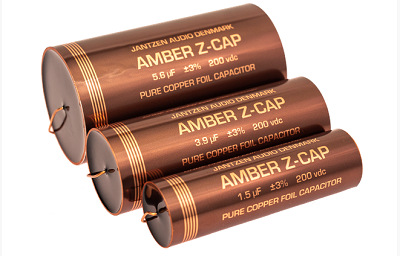
Single lane foil, high-res,
thin insulator capacitors for crossovers.
If you can't live
with the thought of not having the most expensive. Sometimes a tad
better than Alumen-Z, but it may come down to actual recording.
Duelund
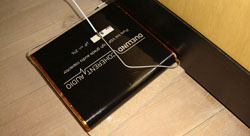
You may wonder why e.g.
Duelund VSF caps are not amount the intro images. The VSP are
"standard" caps wound from e.g. copper foil on oiled paper - and then
squeezed flat to make "virtual stack foil".
These caps
are smooth on the ear but hardly deliver the resolution I expected -
and they're wildly overpriced.
|












